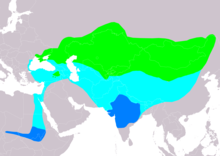| Demoiselle crane | |
|---|---|

| |
| Flock at Tal Chhapar Sanctuary, Churu, Rajasthan | |
| Scientific classification | |
| Domain: | Eukaryota |
| Kingdom: | Animalia |
| Phylum: | Chordata |
| Class: | Aves |
| Order: | Gruiformes |
| Family: | Gruidae |
| Genus: | Grus |
| Species: | G. virgo
|
| Binomial name | |
| Grus virgo | |

| |
| Range of G. virgo Breeding Passage Non-breeding
| |
| Synonyms | |
| |
The demoiselle crane (Grus virgo) is a species of crane found in central Eurosiberia, ranging from the Black Sea to Mongolia and Northeast China. There is also a small breeding population in Turkey. These cranes are migratory birds. Birds from western Eurasia will spend the winter in Africa while the birds from Asia, Mongolia and China will spend the winter in the Indian subcontinent. The bird is symbolically significant in the culture of India, where it is known as koonj or kurjaa.[3]
- ^ BirdLife International (2018). "Anthropoides virgo". IUCN Red List of Threatened Species. 2018: e.T22692081A131927771. doi:10.2305/IUCN.UK.2018-2.RLTS.T22692081A131927771.en. Retrieved 14 February 2022.
- ^ "Appendices | CITES". cites.org. Retrieved 2022-01-14.
- ^ R. K. Gaur (1994), Indian Birds, Brijbasi Printers, 1994, ISBN 9788171070312,
The smallest member of the crane family, the demoiselle crane (Anthropoides virgo) is a distinctive looking bird, with ashy grey ... The local name for this crane — koonj — is onomatopoeic, deriving from the Sanskrit 'kraunch', the origin of the word crane itself
